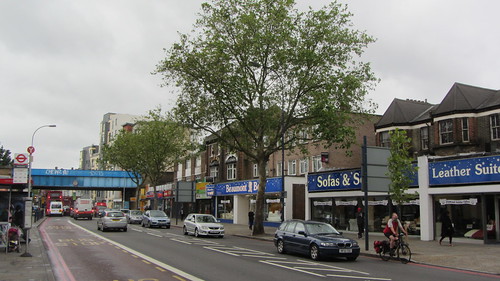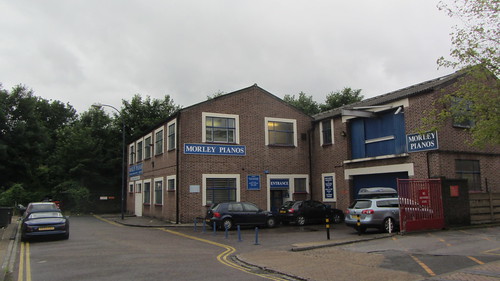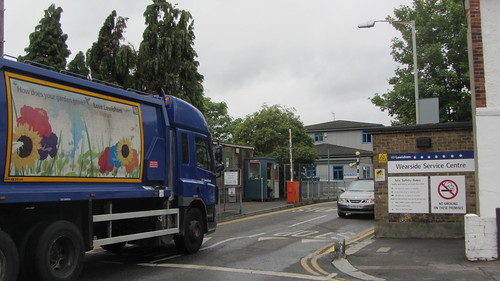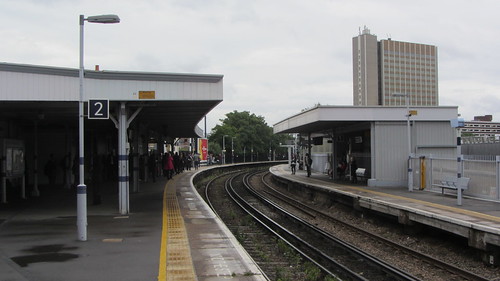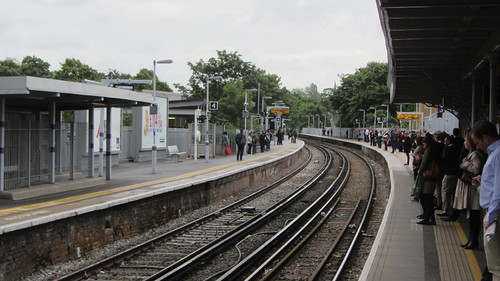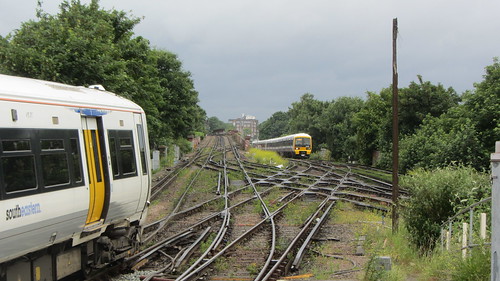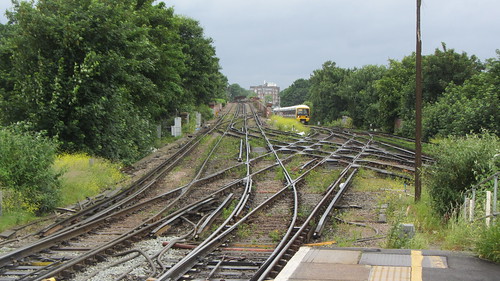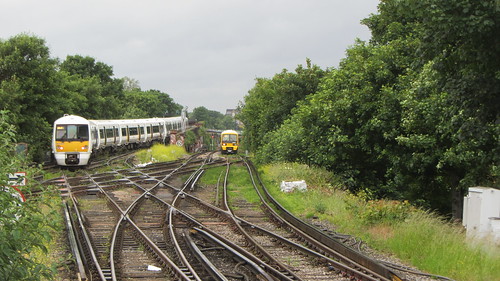Transport for London have recently given some figures for expected growth over the next 20 years in London, and they emphasise the need for investment in transport.
At the recent GLA transport committee, Geoff Hobbs, Head of Strategy, London Rail, TfL, was asked about various issues, including growth. The committee is a question and answer session, which I've tried to transcribe key sections of. See the Webcast at 1hr 51.
Q: Can you tell us a bit about projected passenger numbers in the next 5 years?
A: What we've observed during the recession is a small decline in 2009 and then some really quite substantial increases during 2010 and 2011, and in the world of railways the recession has not bitten at all. We anticipate that to continue growing.
To pick the next 20 years to put it in the long-run context first, we've got growth in employment and population in the London Plan of roundly 14%, and we anticipate railway growth - rail, National Rail - of roundly 40 to 50%. There's a spuriously accurate number of around 43% if I remember rightly. Its much greater than the growth in employment and population because the sorts of places where the growth is occurring, in London Plan jargon "opportunity areas", often tend to be very close to where railways are. You see round here, More London, the Shard, Paddington, Stratford, all the major stations, Liverpool Street, Kings Cross - full of big new buildings where the growth in employment is happening. And in contrast, the sort of places where population is growing, are journeys well made by rail. Thats why we see that dichotomy.
To take the short run view through the next 10 years, then its about half that, 20% if I remember rightly.
To emphasise that, the official estimate is that capacity on rail (possibly including the tube, its unclear) needs to be increased by 40 to 50% in the next 20 years, with the calculated single figure quoted as 43%. This is a massive rise, and fits with an indirectly obtained figure of a 70% increase in total transport capacity in 20 years.
Now, Crossrail is intended to add 10% to the total capacity of rail in London, and Thameslink probably adds another 4 or 5%. So 15 units out of the 43 are already accounted for there. Longer trains out of various stations account for more, but there will still be a gap the size of another 1 or 2 crossrails. Here is how TfL might address some of that demand growth:
Q: Are those figure leading TfL in the direction of improvements that are needed?
A: Very much so. Working closely with National Rail we did a lot of work on the London and South East RUS (Route Utilization Strategy). That's an important document because it has some status in the world of planning, it gets adopted by the Office of Rail Regulation and its the document that feeds into the Government strategic rail planning process, which cumulates in something called the HLOS (High Level Output Statement) in July this year. And that's the process where the Secretary of State for Transport decides how much she wants to spend on National Rail for the 5 years ending 2019.
For that reason, we put a lot of effort into getting a good evidence base, using computer models to describe how much demand we expect to increase and exactly where, to see what the impacts are against a do minimum case. Now, "do minimum" in this instance is actually "do quite a lot", because it includes things like Crossrail and Thameslink and a whole range of other projects that are coming to fruition right now, but they don't solve every known capacity problem. So, we've come up with a range of other projects on some of the other railways around London that will complement some of the big projects that you see extant on site right now.
Q: What can we look forward to?
A: The question isn't related to whether TfL takes over franchises. This is something TfL would want to take forward anyway even if nothing changes in the world of franchising through the Government railway strategic planning process. What we have recommended, and what is in the London and South East RUS and the Initial Industry Plan are the following projects. Number 1, we'd like to see an increase in capacity on the London Overground, longer trains and electrification of Barking to Gospel Oak. Number 2, we'd like to see a big increase in capacity up the upper Lea Valley, which is the bit between Stratford, Tottenham and further north to places like Brimsdown and Ponders End. Number 4 [sic], we think there will be a need for additional capacity on the line out of Waterloo, the South Western sector, particularly towards Richmond, Twickenham and Staines.
And then there is a range of "making the most of what we've got" type projects, more longer trains on the rout out of Fenchurch Street, out of Victoria towards Bromley, and out of Victoria and London Bridge towards Croydon and further south. Thats it in summary, so we've got a range of projects there.
National Rail: In addition there are all the major station schemes too. In Control Period 4 it tended to get overlooked in the process a little bit, but we're in strong agreement of the kinds of capacity schemes we need as well, Fenchurch Street, Waterloo, but also some of the non central stations, Wimbledon, places like that. So, we're pushing for capacity enhancements at stations like that to enable them to cope with the kind of demand we're talking about.
Q: More ticket gates? More staffing?
More ticket gates would definitely be part of it. You see at Victoria for example, if you get two trains arriving at adjacent platforms you get a big bundle, and some of these things are relatively simple, manual gates that can be turned into the wide aisle gates, some of them need changing retail, moving them around so you don't get blockages. And thats something Network Rail are doing right now at Waterloo for example and you'll see other stations having similar works of that nature.
Congestion at stations is always very peculiar and specific to a location. Lots of small individual actions, moving a telephone booth here, adding an extra ticket gate there, these sorts of things not huge in their own right but can make a big difference. Small changes in layout make big differences in crowding.
I note the explicit drawing out of the Richmond/Twickenham/Staines route I discussed in my last blog and also with Swanlink.
Crossrail 2 is also mentioned in the context of HS2 (although reading the growth projections, its probably needed separately from HS2).
Q: I am quite concerned about the amount of capacity on underground and buses when HS2 hits Euston. And there doesn't seem to be any money, and planning available for that?
Its fair to say that we are too. The point we've made at Euston is, the two places where people go most often having arrived at Euston are southbound towards Bank on the northern line, and southbound towards Oxford Circus on the Victoria line, and they are two very, very busy London Underground lines.
Now, there are various things one can do to mitigate the impact, that get harder to do as HS2 gets bigger in various phases. So, the bit to the West Midlands, the solutions are not too massive, but by the time its stretched all the way up to Yorkshire and Scotland, life gets very tricky indeed. The sorts of things that we would want to see done, and the sorts of things that are now beginning to be reflected in the thoughts of HS2 Ltd, are number 1, lots of works to Euston underground station itself, which is really busy right now.
It is over capacity right now. For those of you with an interest in obscure facts, it is the only underground station that you can only get into through another station. Which means that if you want to get out of Euston you have to go through the concourse of Euston National Rail station, which just leads to more congestion.
Number 2, direct access to Euston Square, because the sub-surface lines will have a lot more capacity in the future courtesy of the upgrade. Number 3, there are things you can do to the northern line to upgrade it further.
...
Old Oak Common is a big part of the solution, and making the interchange a big part of the solution, and making that interchange as good as possible, as opposed to an enormous hike.
...
It would be extraordinary indeed if one saves 20 minutes on one's journey from Birmingham if one spends 20 minutes getting out of Euston.
At the end of the day, when HS2 grows to its full extent as planned by Government, we think that there will need to be much more thorough interventions, and what we have in mind by that elliptical language is Crossrail 2. And we've put forward ideas for how that could be made to grow in a staged way so that the cost isn't too enormous all at one time, and that could make a big, big difference. If you built the station between Euston and Kings Cross then thats the obvious place to put it, and run the route through there. We've been looking at the various different routes. North east to south west looks like the most pressured corridor, so we would continue a route something like that.
...
Its by no means an easy build, and there is an enormous amount of work to do. Happily for at least HS2's eventual to Yorkshire and Newcastle and beyond, we've got a bit of time on our side. Not huge amounts, but a bit of time, and we can work out precisely what the best solution is. And there is a solution, its just not an easy one.
I note how TfL emphasises the importance of a good interchange at Old Oak Common, something that I think is vital. Perhaps those in Birmingham might learn the lesson?
Summary
Growth of 40 to 50% in the rail capacity of London is required in the next 20 years, and 70% in total transport capacity. That figure is massive, and emphasises that big money is going to continue to need to be spent in London on transport, even after Crossrail and Thameslink finish in 2018/9.


